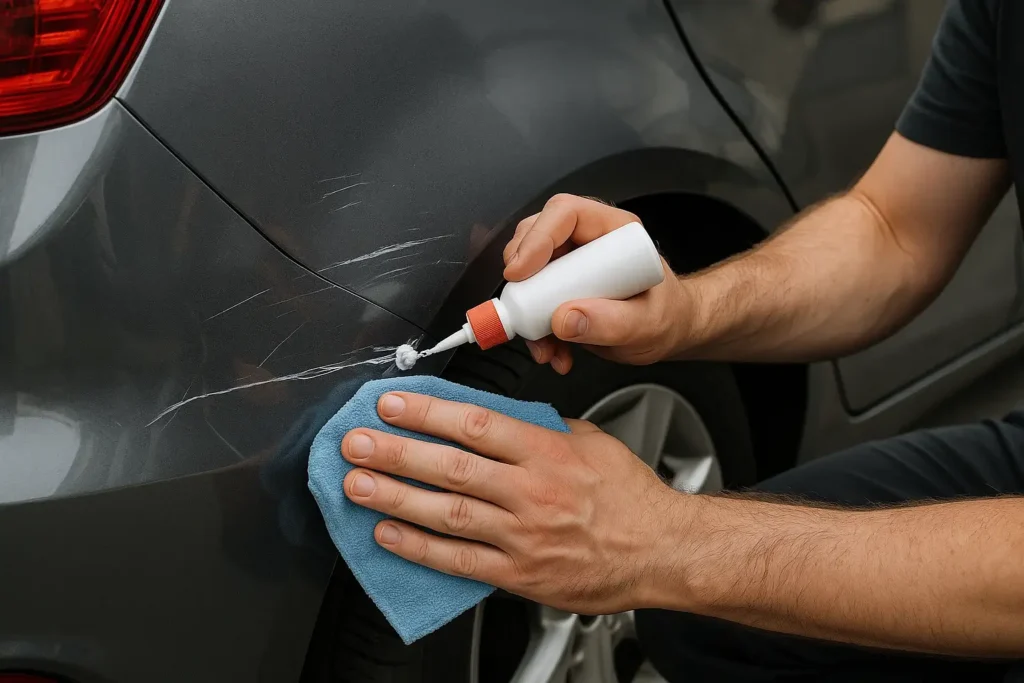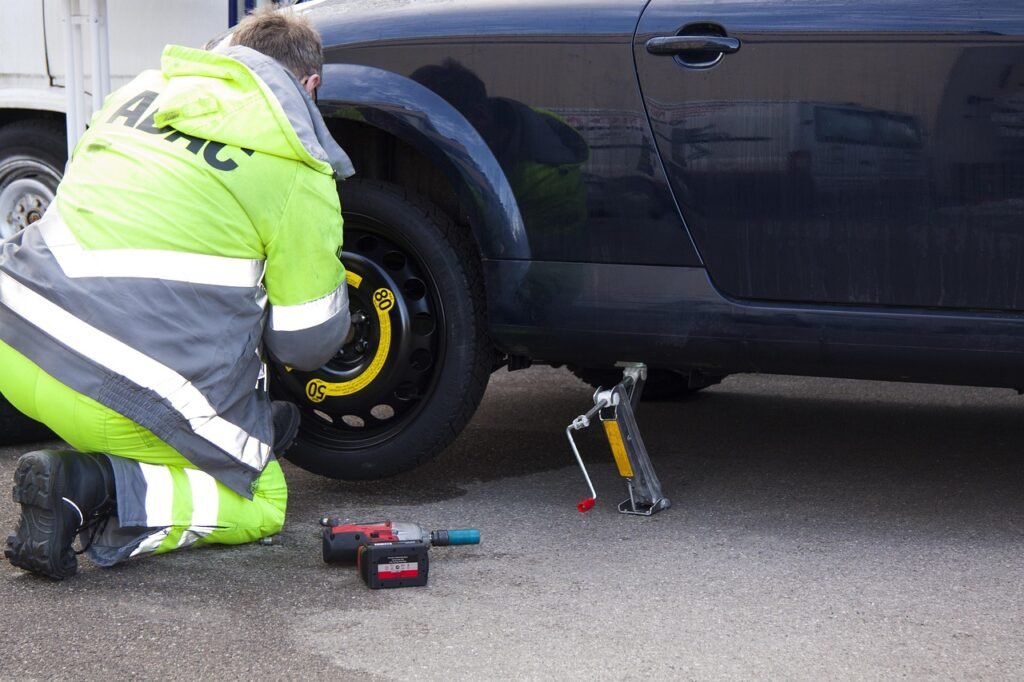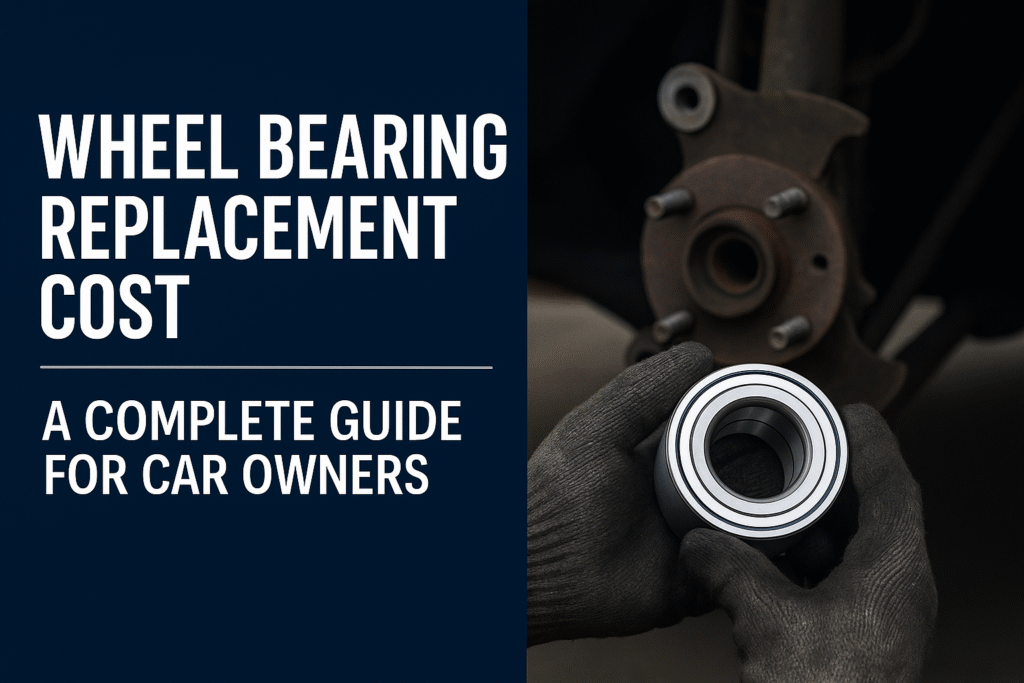Introduction
Whether it’s from an inconsiderate parking neighbor, a rogue shopping cart, or an accidental brush with a bush, car scratches happen to even the most careful drivers. What may look like a minor mark on your car’s paint can have bigger consequences down the line, reducing resale value, accelerating corrosion, or even becoming a costly repair if left untreated.
The good news is that most scratches can be repaired. Sometimes for less than the cost of a tank of gas. In this guide, you’ll learn how to identify different types of scratches, explore DIY car scratch repair techniques, compare professional repair options, and understand what each will cost. Plus, we’ll give you tips to help prevent future scratches and keep your vehicle looking showroom new.
What Kind of Scratch Is It? Understanding Types of Car Paint Damage
Before you decide how to fix a scratch, it’s essential to understand what type of damage you’re dealing with. Your car’s paint is a multi-layer system, and the deeper the scratch goes, the more involved the repair becomes.
Clear Coat Scratches
These are the most superficial scratches and only affect the transparent layer that protects your car’s paint. You’ll often find these caused by:
- Automatic car washes
- Dusty cloths
- Tree branches or fingernails
How to spot it: Run your fingernail across the scratch. If you can barely feel it, it’s likely only in the clear coat.
Repair difficulty: Easy – typically fixable with polishing or a scratch remover.
Paint Scratches (Base Coat Damage)
These scratches penetrate the clear coat and damage the colored paint beneath. You’ll usually notice these from:
- Door dings
- Key marks
- More forceful contacts
How to spot it: Color is exposed but not metal. May feel more pronounced.
Repair difficulty: Moderate – may require touch-up paint or a scratch repair kit.
Primer or Deep Scratches
These are the most serious and may expose the gray primer layer or even the bare metal.
Causes include:
- Deep keying
- Road debris at high speed
- Accidents
Repair difficulty: High – requires sanding, priming, and repainting, preferably by a professional.
Keyed Car Scratches & Vandalism
These often appear as long, deep scratches across one or more panels. If the scratch is deep and uneven, it’s likely intentional.
Action tip: Always document and report these incidents to your insurance and local authorities if vandalism is suspected.
Interesting Read: How to Remove Window Tint?
How to Fix Car Scratches: All Repair Options Explained
Once you’ve identified the type of scratch, you can choose the best repair method—whether it’s a simple polish or a full paint correction.
DIY Car Scratch Repair Methods
DIY options are budget-friendly and can yield great results for surface or shallow scratches.
Buffing & Polishing for Surface Scratches
Best for: Clear coat scratches
What you’ll need:
- Polishing compound (e.g., Meguiar’s, Turtle Wax)
- Microfiber cloth or dual-action polisher
Steps:
- Clean the scratched area thoroughly.
- Apply a small amount of compound.
- Rub in circular motions until the scratch diminishes.
- Wipe clean and seal with wax.
Using a Car Scratch Repair Kit
Best for: Light to medium paint damage
What’s included:
- Sandpaper (varying grits)
- Polishing compound
- Touch-up paint
- Clear coat applicator
Steps:
- Sand the scratch area lightly to smooth edges.
- Apply paint in thin layers.
- Allow drying, then add clear coat.
- Polish the area to blend.
Touch-Up Paint Application
Best for: Small chips or base coat scratches
What you’ll need:
- OEM paint matched to your vehicle’s color code (usually found in the driver-side door jamb or under the hood)
- Fine-tip applicator
Steps:
- Clean and degrease the area.
- Use toothpick or paint pen to fill scratch.
- Let dry and apply clear coat.
Fixing Deep Scratches Yourself
Warning: This is more advanced and requires patience.
Steps:
- Sand the scratch area to remove jagged edges.
- Apply primer if metal is exposed.
- Add base coat using factory-matched touch-up paint.
- Finish with clear coat and polishing.
Limitations: Without proper blending and curing, repairs can look obvious. Deep scratches may require professional help for a seamless finish.
Professional Car Scratch Repair Services
For scratches that are too deep, too long, or in highly visible areas, professional car scratch repair is often the best choice. Skilled technicians use advanced tools and techniques to restore your car’s paint finish to like-new condition.
Paint Correction or Machine Polishing
Best for: Minor to moderate clear coat scratches
What it involves:
- Using a dual-action (DA) or rotary polisher
- Compounding and polishing to level out the clear coat
Benefits:
- Removes swirl marks and oxidation
- Restores paint shine
- No repainting required
Drawbacks:
- Doesn’t fix base coat or primer damage
Spot Painting or Panel Respraying
Best for: Base coat or primer-level scratches confined to a small area
What it involves:
- Sanding down the damaged area
- Applying primer, base coat, and clear coat
- Blending into surrounding paint
Benefits:
- Near-invisible results when done by skilled techs
- Color-matched to your factory finish
Drawbacks:
- Higher cost
- Drying/curing time needed
Mobile Scratch Repair Technicians
Best for: Surface-level scratches, light paint corrections
How it works:
- Technicians come to your home or office
- Repairs completed in 1–2 hours
- No need to leave your car at a shop
Costs: Usually lower than body shops, ranging from $100 to $300 depending on damage
Tip: Look for certified mobile repair specialists with positive reviews and a warranty on their work.
When Insurance Covers Scratch Repairs
In some cases, especially vandalism or collision-related scratches, your car insurance may cover the repair.
Keep in mind:
- You’ll need to pay your deductible first (often $250–$500)
- Too many claims may raise your premiums
- Insurance may not cover small cosmetic damage unless caused by a covered event
Interesting Read: Professional Headlight Cleaning and Restoration
Car Scratch Repair Cost: What You Can Expect to Pay
Car scratch repair costs vary significantly depending on the depth, location, and repair method.
DIY Car Scratch Repair Cost
| Repair Method | Typical Cost Range |
|---|---|
| Scratch Remover Compound | $10 – $30 |
| Car Scratch Repair Kit | $20 – $50 |
| Touch-Up Paint + Tools | $25 – $75 |
| Buffing Tools (DA polisher, pads) | $60 – $150 |
DIY repair is generally low-cost, especially for light scratches. However, results vary based on skill, tools, and the severity of the scratch.
Professional Scratch Repair Cost
| Scratch Type | Repair Method | Cost Estimate |
|---|---|---|
| Clear Coat Only | Machine Polish | $75 – $150 |
| Paint Scratches | Spot Repair/Repaint | $150 – $400 |
| Deep/Primer Scratches | Panel Repainting | $300 – $1,000+ |
Factors that impact cost:
- Type of paint (metallic and pearl are more expensive)
- Panel location (bumpers are usually cheaper than doors)
- Size of the damaged area
- Labor rates by region
DIY vs. Professional Car Scratch Repair: Which Should You Choose?
Let’s break down the pros and cons of each option so you can choose based on your situation.
When DIY Makes Sense
- The scratch is surface-level and doesn’t expose color or metal
- You’re comfortable using tools and following instructions
- You want a budget-friendly solution
Pros:
- Saves money
- Can be done on your schedule
- Great for small or hidden areas
Cons:
- May not fully remove the scratch
- Can result in visible marks if done incorrectly
- Time-consuming for beginners
When Professional Repair Is the Better Choice
- Scratch has penetrated the paint or primer layer
- Damage is on a highly visible area like the hood or driver door
- You plan to sell or trade in your vehicle
Pros:
- High-quality, seamless finish
- Color match guaranteed
- Saves time and effort
Cons:
- More expensive
- May require scheduling and downtime
| Repair Option | Best For | Approx. Cost | Pros | Cons |
|---|---|---|---|---|
| DIY | Light scratches | $10 – $150 | Affordable, convenient | Risk of poor results |
| Pro Repair | Deep or visible scratches | $150 – $1,000+ | Guaranteed quality, resale value | Costly, takes longer |
Recommended Tools and Products for Car Scratch Repair
If you’re planning to fix scratches yourself, using the right tools can mean the difference between a professional-looking finish and a frustrating mess.
Top-Rated Car Scratch Repair Kits
These kits are all-in-one solutions that typically include everything you need for light-to-moderate scratch removal.
Recommended Products:
- Meguiar’s ScratchX 2.0 – Great for clear coat scuffs
- Turtle Wax Scratch Repair & Renew – Easy for beginners
- 3M Scratch Removal System – Includes sanding pads and rubbing compound
Polishing Pads and Buffing Tools
For best results on surface scratches, use a dual-action polisher with foam or microfiber pads.
Recommended Tools:
- Griot’s Garage Random Orbital Polisher
- Chemical Guys Hex-Logic Pad Kit
- Meguiar’s Ultimate Compound

Touch-Up Paint and Clear Coat
When dealing with paint-layer scratches, touch-up paint matched to your car’s exact color code is essential.
How to find your paint code:
- Driver-side door jamb (most common)
- Under the hood (some manufacturers)
- Owner’s manual or VIN decoder online
How to Prevent Car Scratches in the Future
Preventative maintenance and mindful habits can drastically reduce the likelihood of future scratches.
1. Use Covered or Indoor Parking
Protect your vehicle from tree sap, bird droppings, hail, and sun damage—all of which can contribute to paint deterioration and scratching.
2. Wash Your Car Properly
Avoid using dish soap, dirty sponges, or automated car washes with abrasive brushes.
Best practices:
- Two-bucket method (one for soap, one for rinse)
- Use microfiber cloths and drying towels
- Wash every 2–3 weeks depending on weather
3. Apply Paint Protection Products
- Ceramic coatings offer a hard, long-lasting layer of protection
- Paint Protection Film (PPF) protects high-risk areas like the front bumper and hood
- Spray sealants and waxes provide moderate protection and hydrophobic benefits
4. Be Mindful Where You Park and Walk
Avoid tight spaces, overgrown shrubs, and parking lots with heavy foot or cart traffic.
Final Thoughts
Scratches may be part of owning a car, but letting them linger can cause more harm than good. Whether you go the DIY route for minor scuffs or invest in professional car scratch repair, restoring your car’s finish improves not just its look, but also its value and protection from rust and corrosion.
The most important thing is to act early, use the right products, and understand when it’s time to call in a pro. With the right tools and techniques, your car’s paint can look like new again without breaking the bank.
FAQs
What’s the most effective product for car scratch repair?
The best product depends on the depth of the scratch. For light scratches, a quality rubbing compound or scratch remover works well. For deeper ones, touch-up paint that matches your car’s color provides better results.
How much does it typically cost to fix a car scratch?
DIY fixes can cost between $15 and $40. If you go to a body shop, expect to pay anywhere from $100 to over $1,000 depending on how deep or large the scratch is. Costs also vary by location and paint type.
Are scratch repair pens actually worth using?
Scratch pens can work for very light, surface-level scratches, especially on clear coat damage. However, they don’t blend well with deeper scratches and can leave uneven results if not applied carefully.
Can scratches reduce my car’s value when selling?
Absolutely. Even small visible scratches can make your car look poorly maintained, lowering buyer confidence. Repairing them before listing can boost resale value and make your car more appealing.



